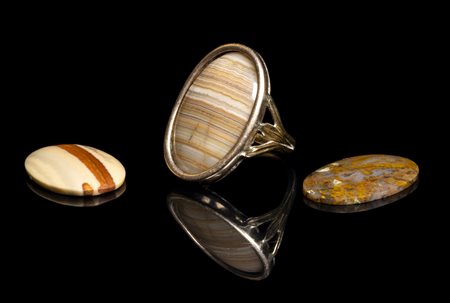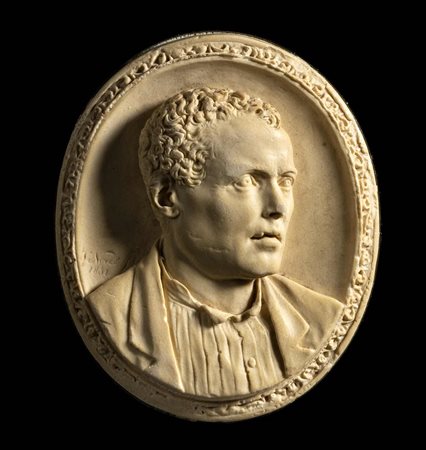ASTA 267 - GLITTICA
-

Lot 457 A ROUND MICROMOSAIC SET IN A GOLD RING. DYONISIAC MASK.
19th century
Mosaic diam. 23 mm; int. Size 18x20 mm; 12,28 gr.
Frontal mask of a Silenus with a wreath of bunches and leaves of grapes. Beautiful polychromy. Probably italian.
Provenance: U.K. private collection -

Lot 458 AN OCTAGONAL MICROMOSAIC SET IN A GOLD RING. THE COLOSSEUM.
19th century
Mosaic 22x35 mm; Int. Size 17x25 mm; 15,70 gr.
Polychrome effigy of the famous ancient monument, symbol of the Eternal City. Probably Italian.
Provenance: U.K. private collection -

Lot 459 A LARGE GRAND TOUR MICROMOSAIC SET IN A WOODEN FRAME. DOVES OF PLINY ON A FOUNTAIN.
18th century
Diam. 77 mm
In the Circle of Giacomo Raffaelli (February 2, 1753 – October 11, 1836). These doves, known as the Capitoline Doves or Doves of Pliny, appear frequently as the subject of micromosaics. The image comes from a Roman floor mosaic discovered in 1737 at Hadrian's Villa in Tivoli, which in turn is believed to be a copy of a lost ancient Greek mosaic at Pergamon. The original is described by Pliny the Elder in his Naturalis Historia (XXXVI, 184): "There is a stupendous dove which drinks and darkens the water with the shadow of its head, while others sun themselves and scratch themselves on the edge of a cantharus".
The same subject was repeated by Giacomo Raffaelli on at least five other occasions, and the oldest specimen known to date, dated 1778, is the one kept in the British Museum in London, while the others are in the Paul Getty Museum in Los Angeles, the Vatican Museums, the Gilbert Collection in London and the Savelli Collection in Rome.
J. Hanisee Gabriel, The Gilbert Collection Micromosaics, Londra 2000, p. 14;
M.G. Branchetti, Collezione Savelli. Mosaici minuti romani, Roma 2004, p. 19 Anna Maria Massinelli, Giacomo Raffaeli (1753 -1836) Maestro di stile e di mosaico, Inprogress S.r.l. 2018,
Provenance: U.K private collection -

Lot 460 A RARE SET COMPOSED BY A GEORGIAN RING WITH THREE INTERCHANGEABLE STONES.
End of 18th century
Stone 15x22 mm; int. diam 17 mm; 2,69 gr.
Probably German, attributable to Johan Christian Neuber of Dresden (circa 1790), an interesting set of three oval interchangeble hardstones (Agate, chalcedony) to be mounted in an openable metal gilded ring. Each of these colored and striated stones has an aesthetic particularity or a mineralogical curiosity. These kind of stones are referable to the "Cabinet of Lithologie" usually made in that period by a leather book-form case with marbleized interior, containing exactly the same kind of specimens.
Provenance: U.K. private collection -

Lot 461 A LARGE LIMESTONE SIGNED AND DATED CAMEO SET IN A METALIC FRAME. MALE PORTRAIT.
19th century
49 x 58 x 14 mm ; 38 grs
Set in a metalic gilded frame, this cameo shows the bust in three-quarters of a man, the head toward right. He is characterized by short curly hair with a large fronthead, realistic features, small nose, semi opened lips and intense look. He wears a shirt and mantle. On top of the left shoulders : J. N…. (to be identified), 1881. Under the bust, engraved inscription "E… Garnet âgé de 53 ans". Knotwork frame. Wear marks. -

Lot 462 A LARGE AGATE CAMEO. PORTRAIT OF A SULEYMAN II (REIGN 1520-1566).
19th century or later
32x35x5 mm
The Sultan Suleyman the Magnificient is facing left. Various anatomical and stylistical elements point towards this attribution; in this case the resemblances in the shape of his turban, the dropping collar, his aquiline nose, fine lips and protruding chin with a refine moustache and slight delineation of the Adam's apple. The portrait is finely carved with mirror polishing and raised by two consecutive carved frames on the edge of the stone, giving the piece an additional touch of preciousness. Very large size.
For a similar portraiture see: from Cristofano dell Altissimo, portrait of Suleyman the Magnificient (1494-1566), Galleria degli Uffizi, Florence and the portrait made by a Follower of Gentile Bellini, circa 1520, sold at Sotheby's on May 1st 2019
Provenance: U.K. private collection acquired on the british art market. -

Lot 463 A RARE UNHEATED CEYLON SAPPHIRE INTAGLIO. KRISHNA RIDING A YALI.
18th century or earlier
Diam 20x5 mm circa
The scene depicts a male character wearing an hindu crown in stupa shape, and riding an hybrid creature toward right. The creature with a lion body and a tiger’s head is depicted with a fierceless look. Groundline. Use of globular elements. The Yali was a mythical lion with special powers.
When the body is that of a tiger, the creature is called a shardula. Yali figures are considered to be a type of grotesque sculpture, meant to inspire fear and awe, and have iconographies similar to other composite mythological creatures, such as the hippogriff and sphinx of ancient Mesopotamia and Egypt. They are also associated with the mythical griffin. Yali figures are believed to act as guardians and protectors, shielding a temple from threats. The tame form of the yali, typically shown flanking short stairways attached to temple plinths with waterfalls emerging from their open mouth, is known as the surul-yali. Yalis were also considered divine vehicles for deities, and were used to signify heroism and the elemental forces of nature, tamed and controlled by being incorporated into architecture and sculpture. Large unheated stone of great rarity. Wear marks. Minor chip on the edge.
See: pair of Architectural Brackets in the form of a rampant leonine creatures (Yali or Vyala), from a processional Mandapa; Madurai, Tamil Nadu, India c. 17th century, ivory with traces of paint, Los Angeles, County Museum of Art. See also: A knight riding the mythological Yali, Jalakanteeswarar Temple, 16th century A.D. and Kesava Temple, Vasu Krishnan, 13th century A.D. Further reserches are necessary.
Provenance: U.K. collection, acquired on the british art market. Accompanied with a U.K. gem laboratory test. -

Lot 464 A POSTCLASSICAL CHALCEDONY INTAGLIO SET IN A GOLD RING. BUSTH OF A YOUTH.
19th - 20th century or later
Stone 14x18 mm; int. size 18x19 mm; 18,59 gr
Three-quarter bust of a youth and head in profile to the left. The character looks up, with a meditative gaze. The long hair is held in a band. The subject is inspired by Hellenistic Greek models.
Provenance: From a private collection, France, acquired on the London art market in the early 2000s -

Lot 465 A GRAND TOUR BLOODSTONE MAGICAL ENGRAVED SEAL SET IN A LATER GOLD RING. HAND USED IN THE WORSHIP OF SABAZIUS WITH ASTROLOGICAL ATTRIBUTES.
19th century
Seal 12 x 14 x 3 mm ; 7,3 grs; int diam 20 mm
The hoop composed of two rounded wires saldered together and separating at the shoulders by a globule on each side. The large squared grooved box-setting is set with a bloodstone seal with a magical engraved design; the Sabazius worship hand with pine, crescent moon and eagle. On each side of the wrist, retrograde initials "A-E". Wear marks.
Provenance: From the collection of an european gentleman, acquired on the art market -

Lot 466 AN EUROPEAN SARDONYX INTAGLIO. COAT OF ARMS EMBLEMA.
18th - 19th century
13,5x17x3,5 mm
In the centre, an eagle with open wings in heraldic style, grasping a sword with its right paw, a pike with its left, and an object (to be identified) with its beak. On the chest, a coat of arms. Below, a cannon with cannonballs. The iconography occurs in a similar way on Prussian silver thalers, especially in the Napoleonic era. Coat of arms to be identified. However, the stone appears to be older, very similar to Roman-era gems. The stone shows strong wear marks and missing on the edge.
Provenance: From a private collection,France, acquired on the art market 1990s-early 2000s. -

Lot 467 A GRAND TOUR CARNELIAN INTAGLIO SET IN A GOLD RING. SEATED MUSE.
End of 18th century
Stone 13 x 17 mm; internal size 17 mm.7.34 gr.
A fully dressed and veiled woman, seated on a chair with turned legs, and holding an ivy leaf up to her face, pensively, contemplates a column on which is seated a boy streatching his arms to her. Footstool and groundline. Behind, a support with an helmet. She is probably a version of a figure of a Muse, after the garnet in hte Cabinet des Medailles (Calpurnie inquiete sur la sort de Cesar, Mariette 1750, pl. 104) which Vollenweider takes to be a portrait of Arsinoe III with an infant Cupid or Bacchus.
D. Scarisbrick, C. Wagner, J. Boardman, The Beverly collection of gems at Alnwick Castle, p. 217
Provenance: U.K private collection from the british art market. -

Lot 468 A POSTCLASSICAL CARNELIAN INTAGLIO SET IN A MODERN SOLID GOLD RING. EROTIC SCENE.
19th - 20th century
Stone 12x15 mm; int. size 16x18 mm; 7,10 gr
A female figure is jumping with widespread legs on a huge phallic idole. On each side, a male figure facing down to the ground. Groundline. Wear marks.
Provenance: From a private collection, France, acquired on the art market in the early 2000s -

Lot 469 A NEOCLASSICAL LARGE CARNELIAN OCTAGONAL INTAGLIO SET IN A MODERN GOLD RING. EROTIC PROCESSION OF A PHALLUS.
19th century
Stone 25x28,5 mm; int. Size 17,5x20 mm; 21,73 gr
The scene depicts an erotic allegorical processiom. On the right side, a monumental altar-shaped chariot supporting a huge phallus. The chariot is pulled by an Erote riding a bull to the left. He is surronded by maenades playing trumpets and an erote riding a goat. The procession is going towards a giant vagina, the lips opened by two erotes as they were opening a curtain. On top, a winged erotes is crowning the phallus with a laurel wreath, as in a triumph. Groundline. Slight wear marks.
Provenance: From a private collection, France, acquired on the art market in the early 2000s -

Lot 470 A GRAND TOUR ERA GLASS IMPRESSION. EROTIC SCENE.
19th century.
13x16x4 mm
Interesting erotic allegory composed of an erect phallus with animal tail and legs advancing to the right; in front of him a snail (symbol of slowness and sexual endurance), above him a bee or fly (symbol of speed); behind, a column with an urn above it and inscriptions to be identified. Groundline. Wear marks. Impression cast in glass after an ancient intaglio.
Provenance: From a private collection, France, acquired on the art market in the early 2000s -

Lot 471 A POSTCLASSICAL RED JASPER INTAGLIO. EROTIC SCENE.
19th - 20th century
24x28x4 mm
A fox is penetrating from behind a woman facing left, with her palms and knees on the ground. In front of her a large vase. Double ground line. Post-classical work on the ancient style. Traces of modern tools not pertinent to antiquity. Signs of wear and small natural defects on the stone surface.
Provenance: From a private collection, France, acquired on the art market in the early 2000s
